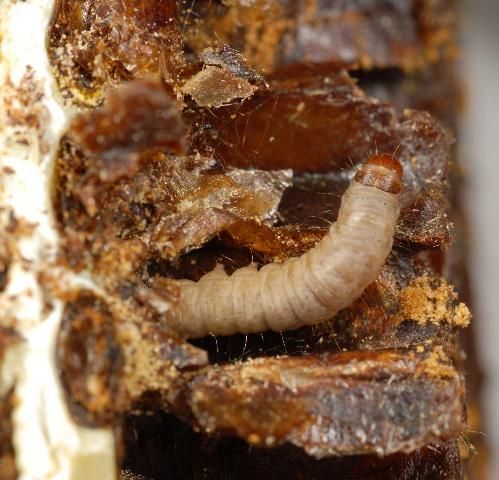The greater wax moth (Galleria mellonella Linnaeus) (Figure 1) and lesser wax moth (Achroia grisella Fabricius) (Figure 2) thrive nearly year-round in Florida's mild climate. Both wax moth eggs and their larvae (Figure 3) can almost always be found in bee colonies, but they are no risk to healthy colonies because they are routinely eliminated by worker bees, which keeps their populations in check. Although they do not create problems in healthy bee colonies, wax moths are nevertheless a serious concern for beekeepers. Not only can they become a problem in a weakened bee colony, they also ruin stored honey bee combs and cause costly damage to beekeeping equipment.

Credit: UF/IFAS

Credit: UF/IFAS

Credit: UF/IFAS
After hatching, wax moth larvae will begin eating beeswax and beeswax contaminants, leaving behind frass (excrement) and webbing (Figure 4). Mature greater wax moth larvae are grey and approximately 20 mm long (Paddock 1918) (Figure 5). These mature larvae are also capable of boring into the woodenware inside the hive, damaging the hive body or frames (Figure 6).

Credit: UF/IFAS

Credit: UF/IFAS

Credit: UF/IFAS
Wax Moth Control in Living Colonies
No chemical control options are available for the control of wax moths in living bee colonies. Generally, a strong honey bee colony will keep wax moth populations low. Large wax moth populations in bee colonies usually result from a reduction in bee colony populations for some other reason (starvation, pesticide poisoning, failing queen, disease, etc.) that allows the moths to become established. Thus, the best defense against wax moths in living colonies is to keep colonies otherwise strong, free of diseases and pests, and queenright. Although they are typically present in weakened bee colonies, wax moths usually are not the direct cause of a colony's demise.
Wax Moth Control in Stored Equipment
Older, darker wax comb is more appealing to wax moths than is foundation or newer, lighter combs. Some of the worst cases of wax moth damage occur in stacks of stored supers containing dark comb. This appears to be the ideal environment for the moth larvae, which build up to large populations quickly.
Traditionally, wax moths in stored supers have been controlled with chemical fumigation. The availability and suitability of fumigant chemicals, however, are constantly in flux. The chemical fumigants legally available for this use in Florida (at time of publication) are aluminum phosphide, methyl bromide, phosphine gas, and magnesium phosphide. These products can be expensive and may require special training and/or a restricted-use pesticide license to use, and there is the ever-present chance the chemicals might find their way into the wax or honey.
Beekeepers should buy any fumigants for beekeeping use from beekeeping suppliers because these companies can provide complete information on use of the substance in beekeeping situations. All pesticides used on stored comb must be labelled for such use. As always, the label is the law, and under no circumstances should a pesticide be used if the particular use is not specified on the label. Exercise extreme caution when using pesticides anywhere near a beekeeping operation.
Alternatives to chemical fumigation have not been found to be practical in large-scale applications but may be useful in smaller outfits.
Temperature manipulation is a safe and effective alternative to chemical control that is not much used in US commercial beekeeping operations, though it is commonplace in commercial operations elsewhere, such as in Australia. The process is simple: place infested honeycomb and beekeeping equipment in a freezer for at least 72 hours and remove after that period, being sure to handle the fragile frozen beeswax with great care so as not to break it.
Light combs can be protected by increasing the flow of light and air through the supers containing them. This is best done under a covered, open-walled shed located outside. Supers containing combs to be protected this way can be stacked at right angles to one another to increase light and airflow through the stack (Figure 7). Although not applicable to every beekeeper's style, this storage method provides maximum ventilation and lighting and is another alternative to chemical fumigation.

Credit: UF/IFAS
Selected References
Egelie, A. A., A. N. Mortensen, L. Barber, J. Sullivan, and J. D. Ellis. 2015. Lesser Wax Moth Achroia grisella Fabricius (Insecta: Lepidoptera: Pyralidae). EENY-637. Gainesville: University of Florida Institute of Food and Agricultural Sciences. https://edis.ifas.ufl.edu/in1108
Ellis, J. D., J. R. Graham, and A. N. Mortensen. 2013. "Standard methods for wax moth research." Journal of Apicultural Research 52(1): 1–17.
Paddock, F.B. 1918. The beemoth or waxworm. Texas Agricultural Experiment Station; USA. 44 pp.